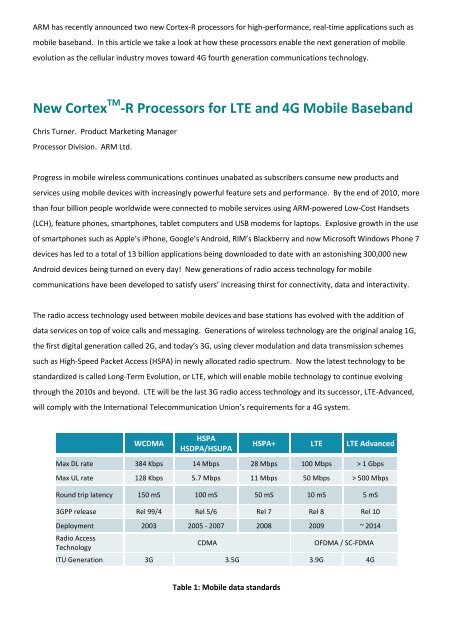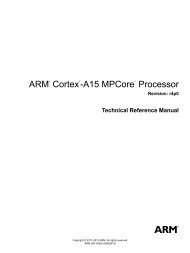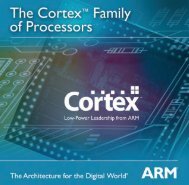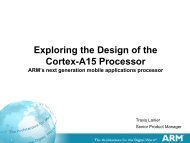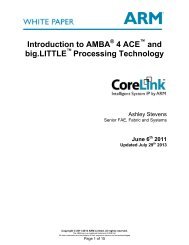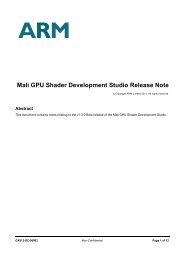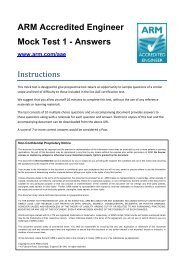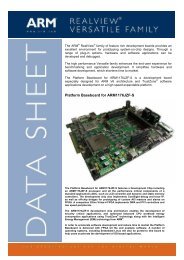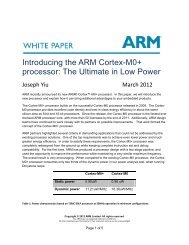New Cortex-R Processors for LTE and 4G Mobile Baseband - ARM
New Cortex-R Processors for LTE and 4G Mobile Baseband - ARM
New Cortex-R Processors for LTE and 4G Mobile Baseband - ARM
- No tags were found...
Create successful ePaper yourself
Turn your PDF publications into a flip-book with our unique Google optimized e-Paper software.
<strong>ARM</strong> has recently announced two new <strong>Cortex</strong>-R processors <strong>for</strong> high-per<strong>for</strong>mance, real-time applications such asmobile baseb<strong>and</strong>. In this article we take a look at how these processors enable the next generation of mobileevolution as the cellular industry moves toward <strong>4G</strong> fourth generation communications technology.<strong>New</strong> <strong>Cortex</strong> TM -R <strong>Processors</strong> <strong>for</strong> <strong>LTE</strong> <strong>and</strong> <strong>4G</strong> <strong>Mobile</strong> Baseb<strong>and</strong>Chris Turner. Product Marketing ManagerProcessor Division. <strong>ARM</strong> Ltd.Progress in mobile wireless communications continues unabated as subscribers consume new products <strong>and</strong>services using mobile devices with increasingly powerful feature sets <strong>and</strong> per<strong>for</strong>mance. By the end of 2010, morethan four billion people worldwide were connected to mobile services using <strong>ARM</strong>-powered Low-Cost H<strong>and</strong>sets(LCH), feature phones, smartphones, tablet computers <strong>and</strong> USB modems <strong>for</strong> laptops. Explosive growth in the useof smartphones such as Apple’s iPhone, Google’s Android, RIM’s Blackberry <strong>and</strong> now Microsoft Windows Phone 7devices has led to a total of 13 billion applications being downloaded to date with an astonishing 300,000 newAndroid devices being turned on every day! <strong>New</strong> generations of radio access technology <strong>for</strong> mobilecommunications have been developed to satisfy users’ increasing thirst <strong>for</strong> connectivity, data <strong>and</strong> interactivity.The radio access technology used between mobile devices <strong>and</strong> base stations has evolved with the addition ofdata services on top of voice calls <strong>and</strong> messaging. Generations of wireless technology are the original analog 1G,the first digital generation called 2G, <strong>and</strong> today’s 3G, using clever modulation <strong>and</strong> data transmission schemessuch as High-Speed Packet Access (HSPA) in newly allocated radio spectrum. Now the latest technology to best<strong>and</strong>ardized is called Long-Term Evolution, or <strong>LTE</strong>, which will enable mobile technology to continue evolvingthrough the 2010s <strong>and</strong> beyond. <strong>LTE</strong> will be the last 3G radio access technology <strong>and</strong> its successor, <strong>LTE</strong>-Advanced,will comply with the International Telecommunication Union’s requirements <strong>for</strong> a <strong>4G</strong> system.WCDMAHSPAHSDPA/HSUPAHSPA+ <strong>LTE</strong> <strong>LTE</strong> AdvancedMax DL rate 384 Kbps 14 Mbps 28 Mbps 100 Mbps > 1 GbpsMax UL rate 128 Kbps 5.7 Mbps 11 Mbps 50 Mbps > 500 MbpsRound trip latency 150 mS 100 mS 50 mS 10 mS 5 mS3GPP release Rel 99/4 Rel 5/6 Rel 7 Rel 8 Rel 10Deployment 2003 2005 - 2007 2008 2009 ~ 2014Radio AccessTechnologyCDMAOFDMA / SC-FDMAITU Generation 3G 3.5G 3.9G <strong>4G</strong>Table 1: <strong>Mobile</strong> data st<strong>and</strong>ards
<strong>LTE</strong> will deliver voice, video <strong>and</strong> data at broadb<strong>and</strong> data rates to mobile devices, enabling any-time, anywhere,always-on high-speed Internet access. Moreover, it will continue to provide service whilst users are on the movein a car or train, travelling at over 200 km an hour. A new generation of highly interactive multimedia mobileapplications will be used on these new <strong>LTE</strong> devices. Imagine carrying a tablet computer out in the countrysideanywhere in the world with instant access to maps, tour guides <strong>and</strong> low-latency interactive multimediain<strong>for</strong>mation relating to whatever you’re st<strong>and</strong>ing in front of or viewing through the camera. However, <strong>LTE</strong> is anadvanced technology <strong>and</strong> exceptionally large amounts of processing are required to support the high data ratesrequired <strong>for</strong> new applications, particularly in the baseb<strong>and</strong> where all the wireless signal processing takes place.Powerful <strong>ARM</strong> <strong>Cortex</strong>-A processors enable mobile devices to run applications on a mobile software operatingsystem together with other <strong>ARM</strong> processors per<strong>for</strong>ming auxiliary tasks <strong>for</strong> interfaces such as touch screens <strong>and</strong>connectivity such as WiFi, Bluetooth <strong>and</strong> NFC. However at the heart of every device there is also a baseb<strong>and</strong>processor that is the digital system <strong>for</strong> transmitting <strong>and</strong> receiving data over the radio. In turn a baseb<strong>and</strong>processor is divided in two parts – a modem to modulate <strong>and</strong> demodulate the radio signal <strong>and</strong> a protocol stackprocessor which manages the communication between base station <strong>and</strong> mobile terminal by establishingconnections, managing radio resources, h<strong>and</strong>ling errors <strong>and</strong> packetizing incoming <strong>and</strong> outgoing data.The tasks in the modem <strong>and</strong> protocol stack processing are distinctly different <strong>and</strong> can be thought of as operationsin orthogonal planes with the protocol stack software being layered according to the OSI model as shown:Figure1: Baseb<strong>and</strong> processing planesThe data plane, or physical layer, is where digitized radio signals are processed in the modem; a system of veryfast digital signal processing logic <strong>and</strong> localized hardware control blocks. This data plane processing is veryintense as <strong>LTE</strong> received data is streamed out of the ADC at around 40 million samples per second with 12-bitresolution. Two streams of so-called I <strong>and</strong> Q radio data are presented <strong>and</strong> the streams are doubled orquadrupled <strong>for</strong> MIMO multiple antenna configurations. The modem’s signal processing tasks are per<strong>for</strong>med by
dedicated hardware incorporating specialized Digital Signal <strong>Processors</strong> (DSPs) with Very Long Instruction Words(VLIW) specifically designed <strong>for</strong> <strong>LTE</strong>’s OFDM modulation technique.The control plane is where layers-1, 2 <strong>and</strong> 3 protocol software stacks manage communications <strong>and</strong> present thesoftware interface <strong>for</strong> voice, text <strong>and</strong> data communications, including video. The protocol stack software in thecontrol plane can be many Megabytes of code <strong>and</strong> may also be required to support pre-existing 2G <strong>and</strong> 3Gmobile wireless st<strong>and</strong>ards. Typically a Real-Time Operating System (RTOS) such as Nucleus or ThreadX willprovide the control plane code environment.High per<strong>for</strong>mance control software is also required at the lowest layer-1 to control the modem, manage radioresources, maintain connection with the base-station <strong>and</strong> respond to changing signal conditions, <strong>for</strong> example bydynamic adjustment of power levels <strong>and</strong> signal conditioning as the h<strong>and</strong>set moves about. A very fast interruptresponse is essential <strong>for</strong> maintaining reliable communications <strong>and</strong> these interrupts must be processed within theallotted time if <strong>LTE</strong> communications are to be maintained. Variations in modem architecture across differentmanufacturers can increase or decrease the layer-1 protocol stack task.The protocol software stack <strong>for</strong> earlier 2G <strong>and</strong> current 3G radio access technologies often runs together withapplications on a single general-purpose processor such as the <strong>ARM</strong>1176 which powers many of the mobilephones shipping today. These systems can allocate around a third of their processing to the baseb<strong>and</strong> withoutcompromising application per<strong>for</strong>mance. However, the latest generation of smartphones <strong>and</strong> tablet computersrun far more dem<strong>and</strong>ing operating systems <strong>and</strong> multimedia applications with increasing features using HSPA or<strong>LTE</strong>. These increasing processing requirements <strong>and</strong> the complexities of chip design caused divergence betweenapplications <strong>and</strong> baseb<strong>and</strong> processing chips which have evolved into distinct semiconductor products in all butthe very lowest cost h<strong>and</strong>sets. This divergence is further emphasized by products such as data modem cards <strong>and</strong>3G USB data modem sticks which contain only the baseb<strong>and</strong> processor.<strong>ARM</strong> <strong>Cortex</strong>-R processors are used <strong>for</strong> the protocol stack processing in these ‘diverged’ baseb<strong>and</strong> processor chips<strong>for</strong> 3G HSPA <strong>and</strong> <strong>LTE</strong>, leading to <strong>4G</strong> <strong>LTE</strong>-Advanced. These protocol stacks consist of a complex set of tasks thatmust meet dem<strong>and</strong>ing real time constraints if communication is to be maintained without data loss. The <strong>LTE</strong> <strong>and</strong><strong>LTE</strong>-Advanced st<strong>and</strong>ards specify critical timings expressed in fractions of a millisecond which the mobile devicemust meet if it is to operate correctly.<strong>Cortex</strong>-R real-time processors offer the requisite high per<strong>for</strong>mance, deterministic response time <strong>and</strong> excellentenergy efficiency that is required <strong>for</strong> 3.9G/<strong>LTE</strong> <strong>and</strong> <strong>4G</strong>/<strong>LTE</strong>-Advance baseb<strong>and</strong> tasks. The <strong>Cortex</strong>-R4 processor isalready firmly established <strong>for</strong> this purpose <strong>and</strong> in January 2011 <strong>ARM</strong> announced two new real-time processors;<strong>Cortex</strong>R5 <strong>and</strong> <strong>Cortex</strong>-R7. Examining the requirements <strong>for</strong> <strong>LTE</strong> <strong>and</strong> <strong>LTE</strong>-Advanced shows how these newprocessors are capable of meeting the levels of per<strong>for</strong>mance necessary to move beyond category-3 data rateswhilst maintaining robust connections at cell edges with high mobility <strong>and</strong> acceptable energy efficiency.
Figure 2: Baseb<strong>and</strong> processing per<strong>for</strong>mance requirementThe per<strong>for</strong>mance required <strong>for</strong> baseb<strong>and</strong> protocol stack processing depends on the architectural choices made inthe modem design <strong>and</strong> associated hardware ‘accelerators’ <strong>for</strong> error correction, compression <strong>and</strong> encryption(ciphering). A Direct Memory Access (DMA) controller can offload the processor with specific features <strong>for</strong>managing fragments of data that are scattered <strong>and</strong> gathered in memory. Flexibility is also important in a modemdesign as dedicated hardware can result in products unable to adapt to changing requirements from networkoperators <strong>and</strong> international st<strong>and</strong>ards. At present, the complexity of <strong>LTE</strong> technology <strong>and</strong> differences in localimplementations is driving a trend towards programmability as opposed to hard-wired logic solutions.An <strong>LTE</strong>-capable mobile h<strong>and</strong>set will probably have the generic system architecture illustrated here.Figure 3: Illustrative baseb<strong>and</strong> architecture
On the left is the radio comprising the antenna, transmit power amplifier, receiver, frequency up/downconversion <strong>and</strong> analog to digital conversion. Data sent over the radio is fed into or out of the modem, shown ingreen. The modem is responsible <strong>for</strong> coding <strong>and</strong> decoding the radio in<strong>for</strong>mation to <strong>and</strong> from a data bit streamwhich is read in or out of baseb<strong>and</strong> level-2 memory. The latest multi-st<strong>and</strong>ard modems occupy many millions ofgates in silicon <strong>and</strong> their designs vary widely across different baseb<strong>and</strong> chip manufacturers where some haveevolved over many generations of mobile technology. Chip manufacturers use different architectures thatdifferentiate their capabilities <strong>and</strong> per<strong>for</strong>mance, although the same hardware <strong>and</strong>/or software architecture isoften adapted <strong>for</strong> different purposes, e.g. LCH, feature phone, smartphone or data card. An associatedapplications processor is shown in red on the right. This could be connected via USB.Incoming <strong>and</strong> outgoing data is managed by a dual core protocol stack processor, shown in blue. System designerswill probably opt to run layer-2 code on one processor <strong>and</strong> layer-3 on the other, taking account of interruptdistribution. Interrupt per<strong>for</strong>mance is key because modem hardware typically generates around 50 interruptsthat must be promptly serviced <strong>and</strong> designers will probably want to route a small number of critical highfrequency interrupts to one processor whist the other supports more periodic events with larger service routines.Some layer-1 control exists in modem hardware but it may also require support from the layer-2 processor.High per<strong>for</strong>mance processors with a fast <strong>and</strong> deterministic interrupt response are required to run these softwarestacks. Approaches to system design vary, but quite often a separate processor is preferred <strong>for</strong> each layer <strong>and</strong>this can relax clock frequency <strong>and</strong> energy consumption, simplify memory implementation <strong>and</strong> partition thesoftware <strong>for</strong> simplicity <strong>and</strong> per<strong>for</strong>mance benefits. A dual processor system like this will generally provide themost energy-efficient architecture <strong>for</strong> longer battery life <strong>and</strong> reduced heat dissipation. A deterministic interruptresponse is critical in this application – if the processor is otherwise busy <strong>and</strong> does not guarantee to serviceinterrupts on time, every time, then data can be lost <strong>and</strong> the connection can drop!This class of baseb<strong>and</strong> processing application is precisely what the <strong>ARM</strong> <strong>Cortex</strong>-R real-time processors areintended <strong>for</strong>. The new <strong>Cortex</strong>-R5 <strong>and</strong> R7 processors are described in detail elsewhere in this issue but somefeatures are particularly relevant to this baseb<strong>and</strong> architecture as follows:High Per<strong>for</strong>mance: <strong>Cortex</strong>-R5 <strong>and</strong> R7 cores provide 1.66 <strong>and</strong> 2.53 DMIPS/MHz respectively, which shouldmeet the most dem<strong>and</strong>ing baseb<strong>and</strong> processing requirement.Coherency: <strong>Cortex</strong>-R5 <strong>and</strong> R7 contain a Snoop Control Unit(SCU) which automatically maintainscoherency between modem data fed into memory <strong>and</strong> the processors’ data cache. This can saveconsiderable software overhead. In the case of <strong>Cortex</strong>-R7 there is also provision <strong>for</strong> coherency betweenthe two processors.Low-Latency Peripheral Port (LLPP): An additional AXI bus port specifically purposed <strong>for</strong> fast control ofmodem hardware without being blocked by large data transactions on the main AXI bus.
Low-Latency RAM (LLRAM): An area of memory used to hold critical software <strong>and</strong> data such as InterruptService Routines (ISR) that can be executed almost immediately without waiting <strong>for</strong> main AXI bustransactions to finish <strong>and</strong>/or <strong>for</strong> the ISR to be fetched into level-1 cache.Tightly-Coupled Memory (TCM): A limited (128 KB) memory resource <strong>for</strong> the most critical code <strong>and</strong> datathat can be accessed without the latency incurred by an AXI bus port. This provides <strong>for</strong> the highest levelof deterministic response to real-time hardware such as an <strong>LTE</strong> modem.Integrated Generic Interrupt Controller (GIC): Allows flexible interrupt distribution <strong>and</strong> rapid interruptsbetween the processors.Low-latency interrupt mode: An interrupt mode particular to the <strong>Cortex</strong>-R processor family which takesinterrupts in as few as 20 cycles.Asymmetric Multi-Processing (AMP): Whilst the <strong>Cortex</strong>-R7 supports Symmetric Multi-Processing (SMP),there is also provision <strong>for</strong> configuring the Quality of Service (QoS) within the SCU block such that eachprocessor can have priority of access to a select range of memory <strong>and</strong> I/O addresses, <strong>and</strong> not be blockedby the other processor. This asymmetry is ideal <strong>for</strong> a system running two separate RTOS instancesexecuting different programs, each with control over its own area of hardware <strong>and</strong> memory but with anoccasional need to transfer data between them.Overall, the new <strong>Cortex</strong>-R5 <strong>and</strong> R7 processors meetthe dem<strong>and</strong>ing needs of <strong>LTE</strong> baseb<strong>and</strong> systemsbeing designed <strong>and</strong> ready <strong>for</strong> deployment this year<strong>and</strong> capable of supporting <strong>LTE</strong>-Advanced when itarrives. <strong>ARM</strong> has a long pedigree in processordesign <strong>for</strong> real-time, deeply embedded applicationswith high per<strong>for</strong>mance <strong>and</strong> low power consumption,meeting the mobile industry’s needs <strong>for</strong>generations. The <strong>Cortex</strong>-R4 processor is currently avery popular solution <strong>and</strong> is used in today’s HSPA<strong>and</strong> first generation <strong>LTE</strong> devices. <strong>Cortex</strong>-R4 islicensed by 20 <strong>ARM</strong> Partners who are shipping it inproducts such as hard disk drive controllers,automotive electronic control units, medicalequipment <strong>and</strong> mobile baseb<strong>and</strong>. Now the <strong>Cortex</strong>real-time roadmap is filled out with <strong>Cortex</strong>-R5 <strong>and</strong>R7, there is a family of processors with per<strong>for</strong>mance<strong>and</strong> features sets addressing the widest range ofhigh-per<strong>for</strong>mance real-time applications.Figure 4: An <strong>ARM</strong>-powered USB modemChris Turner. February 22 nd 2011


